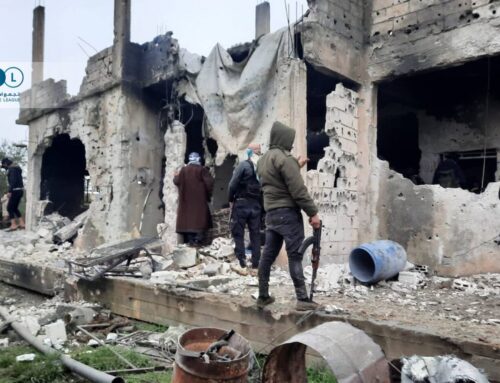Activist: Regime leaving Babila ‘to deploy to other areas’
February 23, 2014 This past Sunday, the Syrian media announced […]
23 February 2014
February 23, 2014
This past Sunday, the Syrian media announced that regime forces had raised their flag in the southern Damascus suburb of Babila after reaching a reconciliation agreement with rebels in the town.
A Syrian government delegation including Outer Damascus Governor Hussein Makhlouf and Fadi Suqour of the Greater Damascus National Defense Forces triumphantly entered the town on Sunday, while images circulated of pro-regime Shiite militants from the National Defense Forces chatting amiably and smiling with rebel fighters.

As part of the agreement, pro-government newspaper al-Watan reported, a week-long ceasefire would be imposed on the town, hungry citizens would have access to humanitarian aid and citizens who fled would be able to return. A week later, no aid has yet entered the city.
The agreement was touted as a government victory and a sign of rebel fatigue in the town, which sits between the Syrian capital of Damascus and the government-controlled Damascus International Airport. Popular efforts “have put an end to a painful period during which the armed terrorist groups wreaked havoc in their neighborhoods,” pro-government Syria Online reported.
As quiet continues in Babila, Rami al-Sid, a media activist in the Damascus suburbs, told Syria Direct’s Mohammed al Haj Ali that rebel battalions remain in control of the city and explains why he believes the truce was rooted in the government’s policy of starvation and its need to divert ground forces elsewhere.
Q: What has happened in Babila between government and opposition forces?
To start, the truce is not a reconciliation pact. The government has taken advantage of it in the media, marketing it as a reconciliation pact while it is a truce. Rebel fighters are still stationed in their position, and government troops do not control the town. There is only one shared checkpoint between the Free Syrian Army and government forces, to make the entry of aid easier. Shelling has stopped on Babila. None of the population that fled has returned [to Babila]. A number of workmen have entered to rebuild the infrastructure, like electricity, and opening the roads, and removing rubble. Real work has begun.
Q: There’s a shared checkpoint between regime and opposition forces? What’s the role of this checkpoint and how did it take shape?
There are three checkpoints: a Free Syrian Army checkpoint, a checkpoint shared between the regime and Free Syrian Army troops, and a regime checkpoint. The checkpoints inspect, verify and oversee entry and exit into Babila, in addition to supervising the entry of aid into the area. They do not constitute barriers for Free Syrian Army battalions. There were some individuals in the ranks of the Free Syrian Army who formed these checkpoints, who long ago surrendered, and they are named the People’s Protection Forces. To be honest, most of the battalions do not recognize the truce, but the most important [thing] is the bad situation the people are in, the continued blockade. That has pushed the blockades to be steadfast.
Q: What groups remain in Babila and are not recognizing the truce?
Ahrar a-Sham, the Islamic State in Iraq and a-Sham in addition to Liwa Sham a-Rusul. The important thing is the truce did not come by way of the Free Syrian Army, but by the intervention of a number of Sheikhs [negotiating with] the regime. That is why calm prevails on all sides and there are no clashes.
Q: Does the truce represent a victory for the regime?
The regime has obtained a victory in the media only, at the expense of children, women and the elderly who are hungry and sick as a result of a long, continuing blockade. War traders [profiteers] also participated with them. They live among us, but quickly returned and dove back into the arms of the regime. But on the ground, no victory was achieved. [The regime] used every type of weapon and did not gain control of the city, but rather systematically used the weapon of starvation, considered a war crime in international law. [By starvation] the regime was able to achieve a media victory only. The Free Syrian Army still controls all of Babila.
Q: Has any humanitarian or international organization entered Babila since the truce?
As of now, no humanitarian or international organization has entered the city. But a number of government figures have entered, like the governor of Greater Damascus with some of the town’s sheikhs, who were one side of the truce with the regime. Some aid has entered, but I do not know who or where it came from.
Q: Why do you think the Syrian government wanted to create a truce in the city, even if, as you say, it did not mean taking control?
On one hand, the regime is trying to calm the neighborhoods in order to gather its forces and deploy them to other areas. On the other, it is trying to send a message to the international community that the regime will remain in power. It is trying to reconcile [with armed groups] and unite its ranks, so that everyone returns into the arms of the state to stand against terrorism. So far, no area has seriously been satisfied with the aid that has entered [their neighborhoods]. Some is delivered from time to time.
For more from Syria Direct, like us on Facebook or follow us on Twitter.








